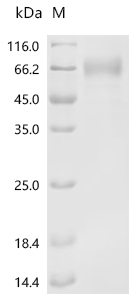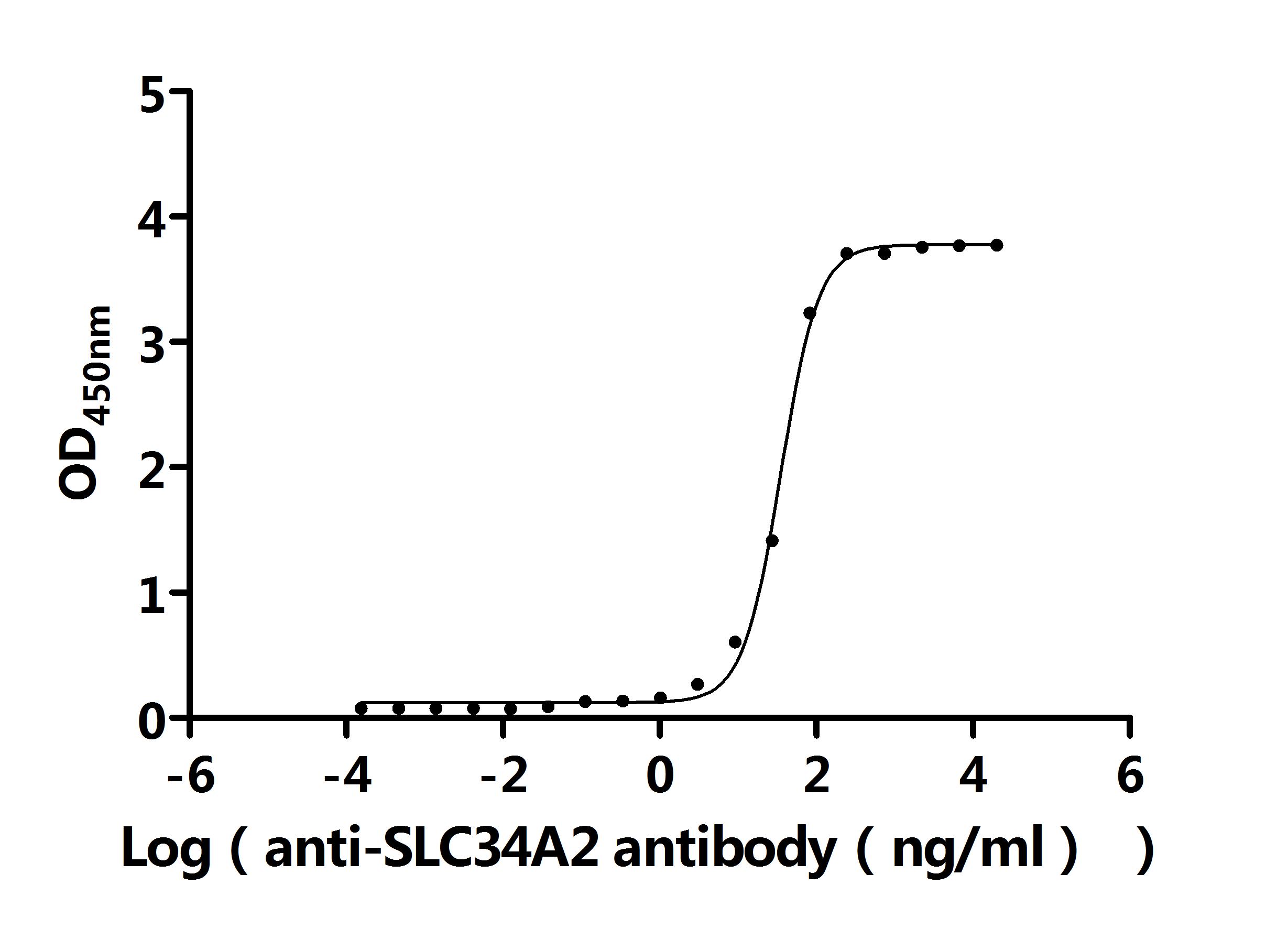The recombinant human SLC34A2 protein is expressed in mammalian cells, which allows for proper post-translational modifications critical for its function. The recombinant SLC34A2 protein corresponds to the amino acid sequence from 234 to 362 of the human SLC34A2 protein, which is essential for its transport activity. It is tagged with a 10xHis tag at the N-terminus and an mFc tag at the C-terminus, facilitating purification and detection. Its endotoxin level is less than 1.0 EU/μg, as determined by the LAL method, ensuring low toxicity for experimental applications. The SLC34A2 protein's functionality is assessed in a functional ELISA. At a concentration of 2 μg/mL, immobilized SLC34A2 can effectively bind to the anti-SLC34A2 recombinant antibody (CSB-RA021581MA2HU), with an EC50 value ranging from 32.86 to 37.66 ng/mL, indicating its potency in binding interactions.
The human SLC34A2 protein plays a vital role in phosphate transport within the body. SLC34A2 primarily functions as a sodium-dependent phosphate transporter that facilitates the transcellular absorption of inorganic phosphate. This phosphate transport is crucial for several physiological processes, including phosphate homeostasis and cellular differentiation, particularly within the type II alveolar epithelial cells in the lungs [1][2][3].
SLC34A2 synthesizes surfactant in alveolar type II cells and is essential for reducing surface tension and preventing alveolar collapse [4][5]. Dysregulation or mutations in this SLC34A2 gene can lead to pulmonary alveolar microlithiasis, a rare lung disease characterized by the accumulation of calcium phosphate [6][7]. Additionally, SLC34A2 expression is linked to cancer pathology. For instance, higher levels of SLC34A2 have been associated with improved prognosis in non-small cell lung cancer (NSCLC) patients [8][9][10]. SLC34A2 has been implicated in various malignancies, including ovarian and thyroid cancers, potentially serving as a therapeutic target in antibody-drug conjugate (ADC) treatments aimed at tumors expressing this protein [9][10].
References:
[1] X. Zhang, X. Ke, et al. Microrna-410 acts as oncogene in nsclc through downregulating slc34a2 via activating wnt/β-catenin pathway. Oncotarget, vol. 7, no. 12, p. 14569-14585, 2016. https://doi.org/10.18632/oncotarget.7538
[2] D. Wu, S. Hu, Y. Hou, Y. He, & S. Liu. Identification of potential novel biomarkers to differentiate malignant thyroid nodules with cytological indeterminate. BMC Cancer, vol. 20, no. 1, 2020. https://doi.org/10.1186/s12885-020-6676-z
[3] N. Kurabe, T. Hayasaka, et al. Visualization of phosphatidylcholine (16:0/16:0) in type ii alveolar epithelial cells in the human lung using imaging mass spectrometry. Pathology International, vol. 63, no. 4, p. 195-200, 2013. https://doi.org/10.1111/pin.12050
[4] Y. Li, X. Chen, & H. Lu. Knockdown of slc34a2 inhibits hepatocellular carcinoma cell proliferation and invasion. Oncology Research Featuring Preclinical and Clinical Cancer Therapeutics, vol. 24, no. 6, p. 511-519, 2016. https://doi.org/10.3727/096504016x14719078133483
[5] Z. Liu, X. Zhao, et al. Heterogeneous pattern of gene expression driven by ttn mutation is involved in the construction of a prognosis model of lung squamous cell carcinoma. Frontiers in Oncology, vol. 13, 2023. https://doi.org/10.3389/fonc.2023.916568
[6] H. Al-Maghrabi, G. Mokhtar, J. Al‐Maghrabi, & A. Meliti. Pulmonary alveolar microlithiasis: a report of two unique cases. Respiratory Medicine Case Reports, vol. 29, p. 100980, 2020. https://doi.org/10.1016/j.rmcr.2019.100980
[7] H. Olauson, V. Brandenburg, & T. Larsson. Mutation analysis and serum fgf23 level in a patient with pulmonary alveolar microlithiasis. Endocrine, vol. 37, no. 2, p. 244-248, 2010. https://doi.org/10.1007/s12020-009-9299-3
[8] L. Cao, Z. Cao, et al. Detection of potential mutated genes associated with common immunotherapy biomarkers in non-small-cell lung cancer patients. Current Oncology, vol. 29, no. 8, p. 5715-5730, 2022. https://doi.org/10.3390/curroncol29080451
[9] K. Lin, B. Rubinfeld, et al. Preclinical development of an anti-napi2b (slc34a2) antibody–drug conjugate as a therapeutic for non–small cell lung and ovarian cancers. Clinical Cancer Research, vol. 21, no. 22, p. 5139-5150, 2015. https://doi.org/10.1158/1078-0432.ccr-14-3383
[10] D. Gerber, J. Infante, et al. Phase ia study of anti-napi2b antibody–drug conjugate lifastuzumab vedotin dnib0600a in patients with non–small cell lung cancer and platinum-resistant ovarian cancer. Clinical Cancer Research, vol. 26, no. 2, p. 364-372, 2020. https://doi.org/10.1158/1078-0432.ccr-18-3965





